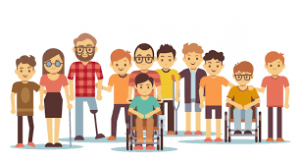The digital divide is a term that refers to the gaps in access to information and communication technology. A person’s access to digital technology can have major impacts on social equality and health outcomes.The Australia Digital Inclusion Index 2019 report found that the rate of digital inclusion in Australia is increasing, but that some members of the community face real barriers to online participation. So what are some of the ways companies and organisations can make their websites and content more accessible to these members of the community?

Infographic illustrating a range of people in the community
Digital inclusion is measured in 4 ways:
- Availability: the quality and level of access to digital technology is considered.
- Affordability: the cost of access in relation to average income and market competition.
- Relevance: access in relation to local content and context.
- Readiness: whether people have the capacity and willingness to learn the skills that are essential for using digital technology effectively.
Whilst Australians have more digital access than ever before, their digital ability isn’t increasing at the same rate. In terms of digital inclusion ‘their readiness’ or lack thereof, prevents some members of the population from using digital technology meaningfully. Groups belonging to low income households, the elderly and the indigenous Aboriginal community tend to be digitally excluded. This places essential services and companies that are slowly moving into the digital sphere in a tricky situation, as members of the community belonging to these vulnerable groups either struggle to access digital media or struggle to use it effectively.
This is not the first time people have struggled to adapt to new forms of communication. 200 years ago, only 12% of the global population were considered literate. Now, that statistic has reversed, with only 14% of the global population unable to read or write, however it now some of the poorest countries in the world that account for this statistic. There is growing concern that digital literacy is following a similar trend, and that those who would benefit most from being connected are at risk of being left behind.
Promoting digital literacy and teaching members of the community how to engage meaningfully with digital technology is crucial to closing the gap in the digital divide. But as with reading and writing, some forms of content are easier to consume and create than others. Digital literacy means being able to make sense of digital media and is evaluated by an individuals:
- Grammar
- Composition
- Typing Skills
- Ability to create text, designs and audio using technology
There are several ways you can make a website more user friendly so that everyone, including those who are still learning to become digitally literate can use it. For example a digitally inclusive website should strive to:
- Offer alternatives to certain types of media. For example, a text media alternative for a picture.
- Content can be presented in different ways without losing structure or integrity. For example, mobile to desktop.
- Content is readable and sufficiently contrasting with the background so that even those with vision impairment can easily interpret it.
- Structure the website in such a way that it assists users in navigating the website and finding the content they are interested in.
- Maximise compatibility with assistive technologies, such as screen readers.
Ultimately, raising the level of online engagement not only has benefits for individual members of the community, but large groups and businesses. Web 105 is an organisation that specialises in optimising websites and developing them so that they reflect universal accessibility guidelines. Head to our services page to learn more about what Web 105 can do to make your website digitally inclusive.
